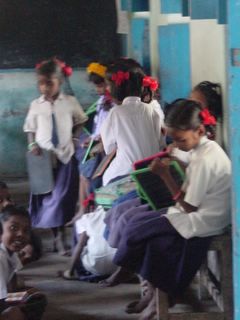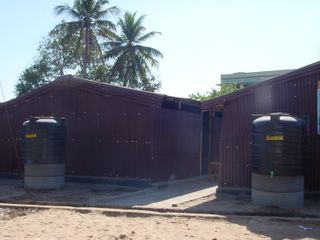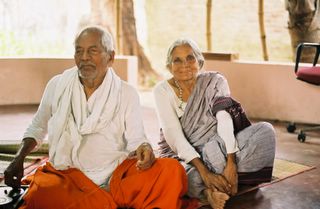We notice that there is no power distance between Amma and the workers, or her staff, visitors like ourselves, or the Dalits working at brickmaking or other activities. She is very physical, often touching people in a society which has long practiced untouchability. This touching is especially important for those she is working with, a demonstration that there is an alternative path to this rigid, seemingly uncompromising social system and its skewed hierarchy of values.
Touching. It is a significant part of her message, whether holding hands with those she is talking, putting her arms on their shoulders, grabbing their forearm. Always looking deeply and directly into their eyes. And when she touches you, you are drawn to her space and place, to the needs that are there and the question of how/what are you going to do about it!
I am reminded, too, of Amirthamai, the “hugging guru” from Kerala who has assembled devotees in the hundreds of thousands, giving as many as ten thousand hugs a day from morning to night, and who has done very good work around her ashram in Kerala (including tsunami relief work, that part of the Kerala coast where her ashram is located having been affected badly, too, as Matt, one of Sekar’s University of Wisconsin students has told me).
Amma treats them all alike, speaking with affection at times and chiding them like a mother at other times. Power distance is based on fear, and Amma will have none of that. That does not mean she will not speak her mind. She is very strong in responding to anyone she thinks is looking for a hand-out or a free ride, scolding them sometimes in coarse and rude language that would be unthinkable from anyone else: “What kind of beggar do you think you are??? If you think like a beggar you will become one.” But somehow she gets away with it, partly because of her age, and certainly the enormous respect she has from everyone for what she has done over the years. We do get comments and grumbling from some of her workers later about this, but it sounds more like children complaining how their mother is treating them, the real issue being her attention and affection. I have to say that my ears burned on a few occasions!
But who else can motivate people to build 26 houses in 30 days? That is the time she told us which one Self-Help Group recently took for the construction of new houses. “Now we are asking them to help others,” she says.
It is this community-building, the larger issue of working together against oppression and the system, that Amma is so good at. A few harsh words here and there can be tolerated and forgiven. We also noticed and later talked with two older people, a man and a woman, loners who were hangers-on in the LAFTI compound. Each had lost everything to money-lenders or poor life decisions. Each often tries to get Amma’s ear when they can to ask for lands or a cow, and, we might add, each seems to not quite be all there. And each time Amma roundly chides them and gets them to do odd-jobs around the compound, feeding them, and all who come to LAFTI if they have the courage and the will to help themselves.
We return for lunch to the LAFTI compound, but before we begin Amma sends us off to her girls’ hostel. She runs both a girls and a boys’ hostel, the later at LAFTI, places for children from remote villages to stay to get them closer to the schools they attend. “I do not want them, the next generation, to just do what their parents did. That would be ok, too, if they choose it. But they should have a choice.” In fact, as we see from later interviews, that is precisely what happens to the more successful families whom Amma and Appa have helped. Not only are they able to build a successful lifestyle, but their children marry up and often move out to the city. Ramu, one Dalit farmer who has been successful enough to purchase his own lands after receiving some from Amma, shakes his hands in the Tamil gesture of “What to do?” and says clearly that the land and farming will go out of his family with his generation, despite the success.
We arrive at the Vallivalam hostel after a bone-shaking ride of 40 minutes, see the buildings and gardens with the warden, Ms. Kannagi, and her teachers. The students, who range in age from 6 to 17, grow their own food and have some lessons at the hostel as well as those of the nearby schools. Vallivalam Primary School, about a ten minute walk to the south, past a large irrigation tank/pond, and the Vallivalam Higher Secondary School are both highly-rated schools in the area.

I am searching for the right place to give the many drawings and paintings which the students of Kobe Elementary School have made for victims of the tsunami as well as monies they have raised. Kannagi helps us later to deliver these to the Vallivalam Primary School.
We return to LAFTI, exhausted, have our ‘sapadu’ rice lunch with curries and sambar, and then take a quick nap. Soon the door swings open, Muttukumar telling us Amma wants to take us to three or four projects, some right along the coast where the tsunami damage had occurred. We rouse ourselves and get back in the Tata Sumos, a rugged SUV and one of the vehicles of choice for Indian roads, so-called.
These later afternoon visits take us to benami lands (lands held illegally in someone else’s name) that are even deeper in thorns and I find myself pulling the mullu from my chapels (sandals). There are also temple lands which lie fallow in another location, another target for Krishnammal’s efforts. She wants us to document a Dalit village of thatched mud huts packed closely together, too, which she says she is going to change and another not far from the coast where the tsunami came up to the tops of the doors.
She speaks disparagingly of the mud huts. They leak, harbor insects and vermin, are washed away during heavy rains, their roofs collapsing, their mud floors turning into a soup that is mixed with all the dust and dirt of the street and nearby fields. Don’ft forget, there are no toilets in Indian villages generally, the expectation being that the nearby fields work fine early in the morning. One does have to watch where one walks. When the summer comes the dust that blows around is potent, so it is not only stomach but also respiratory ailments that are easy to get. The people living in these villages demonstrate a remarkable resiliency in the face of these challenges, but their life expectancy is short and there is little solace if one becomes ill, the nearest hospitals far away and no money in any event for any treatment. Infant mortality in these circumstances is, not surprisingly, somewhat high and also one reason to have many children. You don’t know how many will survive.
Reminder: We need letters of support for our nomination of LAFTI, Amma and Appa for the Right Livelihood Award. You can see this award at www.rightlivelihood.org We do not need anything very long or fancy, just your letter of support and appreciation for their important efforts. Send a copy to Sweden, at the address below, and e-mail a copy to David at shantinik@earthlink.net
The more letters the better, so please encourage your friends, too. These letters can be in any language. We can also send you a model letter. I have asked David to post a sample below. Thanks so much to all of you. We need the letters by April 1. You can send them directly to the Right Livelihood people – the sample letter, from Peggy Burns, shows the address. Please help Amma and Appa, who are doing such wonderful work!
--
Letter from Peggy Burns:
February 28, 2005
Kerstin Bennett, Administrative Director
Right Livelihood Award
PO Box 15072
S-10465 Stockholm
Sweden
RE: Nomination of S. Jagannathan and Krishnammal Jagannathan, and LAFTI (Land for Tillers' Freedom) for the 2005 Right Livelihood AwardDear Dr. Bennett and Members of the Committee:
I was once asked to name a person, living or dead, with whom I would most like to have lunch. I immediately thought of Mahatma Gandhi because I had always been fascinated with the story of how he had the courage to take on the British Government, speak out against the caste system, and change the course of history. Six years ago, I had the honor of sharing a meal with a remarkable Gandhian couple, S. Jagannathan and Krishnammal Jagannathan, founders of Land for Tillers' Freedom (LAFTI). Like Gandhi, they believe in the power of the human spirit and that anything is possible. They have had a deep impact on my life, as well as on the lives of everyone they encounter.
I listened to the story of how Jagannathan courageously took on the multinational shrimp industry to win an Indian Supreme Court decision to close the shrimp farms. These farms had been destroying the land, the fresh water supply, and the livelihood of people living in the coastal villages in the Nagapattinam District of Tamil Nadu. Unfortunately, Jagannathan's "victory" in the Courts did not bring an end to the shrimp farms, but he refused to give up. During my subsequent visits to India, I watched as he so eloquently inspired the people in the surrounding villages to raise their voices and drive the shrimp farms out of India. In spite of his advanced age and failing eyesight, he frequently met with government leaders and laboriously wrote letters warning them about the devastating effects of these farms on the environment. Since the tsunami, we now know he was right, and many groups around the world have begun to take up his cause.
The people of the Nagapattinam District of Tamil Nadu refer to Jagannathan as "Appa" (Father). Like a father, he is their leader, their problem-solver, and their protector.
Krishnammal is the most amazing woman whom I have ever met. She was born into extreme poverty in a Dalit (commonly referred to as “Untouchable”) community and dedicated her entire life to serving her people. Krishnammal is lovingly known as "Amma" or "Mother" throughout the region. She is comforting and gentle, yet strong and confident. For many years, she has had a dream of replacing damp, poorly ventilated mud huts with brick houses. She once wrote to me that as she traveled through the villages, she observed that children were always sick, and she felt this was due to their impoverished living conditions. Since sick children cannot succeed in school, she had to find a way to build more houses and improve their living conditions. A few years later, I traveled with her through the district, and I understood what she had told me. Children living in villages where LAFTI had built brick houses appeared to be bright-eyed and healthy. In villages where families still lived in mud huts, all the children had coughs and runny eyes and noses.
As we continued to drive through the many villages, word rapidly spread that "Amma is coming," and everyone ran to greet her. As a mother, she listened to their problems, handed out a few rupees to those in need, and offered words of encouragement and hope. She promised to help provide an acre of land and a house for each family, but they had to help with the labor and, if possible, make a small financial contribution. She taught them how to form savings groups and to work together as a community. Traditionally, India has been a male dominated society, especially among the poor. In order to break this cycle and empower women to reach their fullest potential, Krishnammal has been placing the ownership of the land and the houses in the women’s names.
Although Krishnammal has very few material comforts or personal possessions, her life is richly endowed with love and mutual admiration. I once tried to give her an umbrella. With a smile and a wave of her hand, she said "I have no needs," and she handed it to someone else. This small gesture so typifies Amma. She taught me that happiness comes from within and that anything is possible.
Jagannathan and Krishnammal strongly believe in the power of education, and they helped to educate hundreds of children over the years. Through LAFTI, they established three hostels for orphaned children and operate several job-training facilities for adults. Most of LAFTI’s staff came from the surrounding villages, and many received their training through LAFTI’s programs.
Krishnammal and Jagannathan have provided the Dalit villagers with the tools (i.e., an education, job skills, land and housing) for a better life. Moreover, they have helped to instill the confidence and pride to succeed, and they planted the seeds for future generations.
The people of Tamil Nadu already know and love their Amma and Appa. Through the Right to Livelihood Award, the rest of the world would be able to honor this extraordinary couple and recognize their many achievements. Thank you for considering this nomination.
Sincerely,
Peggy Burns
Social Worker






